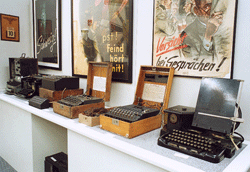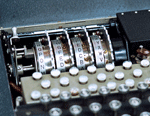The Enigma Code Machine
Please take the time to enjoy a small selection of the artifacts that we have on display at the Museum of World War II. Every artifact in our collection has its own history, and ties to human lives. Each artifact has a small section of its story told here. You can use this map to jump to any section of the Museum of World War 2 to view a selection of the artifacts displayed there. You can click any image for a larger view. This section contains artifacts specifically about the Enigma Machine. In preparation for their new form of warfare, the Blitzkreig, the Germans recognized that their troops would be advancing too fast for land line communications, and that short weave radio had to be relied upon. Because anyone can hear Morse code sent by short wave a new invincible code system had to be developed. It was Enigma, and the Germans believed to the end of the war that it could never be broken. PLEASE NOTE: All firearms displayed at the Museum of World War II have been rendered inoperable. |
|
 In preparation for their new form of warfare, the Blitzkreig, the Germans recognized that their troops would be advancing too fast for land line communications, and that short weave radio had to be relied upon. Because anyone can hear Morse code sent by short wave a new invincible code system had to be developed. It was Enigma , and the Germans believed to the end of the war that it could never be broken.
In preparation for their new form of warfare, the Blitzkreig, the Germans recognized that their troops would be advancing too fast for land line communications, and that short weave radio had to be relied upon. Because anyone can hear Morse code sent by short wave a new invincible code system had to be developed. It was Enigma , and the Germans believed to the end of the war that it could never be broken.
The Army version had 3 rotors, and the order of these rotors was changed each day according to an instruction sheet. Next, the order of the 26 plugs was changed, and then the three rotors were set to specific letters. All of the Enigma machines on a network had to be sent up initially according to the top secret instruction sheet.
If the instruction sheet was captured along with an Enigma machine it would compromise the code, so a fool-proof further system was devised so that each message had its own code. First the sending operator picks three random letters, sets his rotors to those letters and sends these in plain Morse code to the receiving Enigma operator. He sets his rotors to these 3 letters. Then the sender picked 3 new random letters and types these into his Enigma which gives him 3 encoded letters. He sends these by radio, the receiving Enigma operator enters these three encoded letters into his machine, and it shows as the second set of 3 letters.
 The receiving Enigma operator then knows how to set his 3 rotors-both the sender and receiver will have their machines synchronized.
The receiving Enigma operator then knows how to set his 3 rotors-both the sender and receiver will have their machines synchronized.
During the war, the basic settings of the rotor order and plug boards of the Enigmas was changed every eight hours and then every hour. The rotor settings, the individual letters, were changed for every message. The number of possible settings on the three rotor Enigma is 2 x 10 to the 145th power, or12, 276, 989, 683, 567, 292, 244, 023, 724, 793, 447, 227, 628, 130, 289, 261, 173, 376, 992, 586, 381, 072, 041, 865, 754, 882, 821, 864, 156, 921, 211, 571, 619, 366, 980, 734, 115, 647, 633, 344, 328, 661, 729, 280, 000,000,000,000,000.
 The effort to break Enigma was so enormous that the Allies feared the Russians would capture Enigma machines and use them with the knowledge of how they had been broken. They offered a $7500 bounty for Enigma machines at the end of the war and destroyed all those that were not destined for museums.
The effort to break Enigma was so enormous that the Allies feared the Russians would capture Enigma machines and use them with the knowledge of how they had been broken. They offered a $7500 bounty for Enigma machines at the end of the war and destroyed all those that were not destined for museums.
Enigma was broken in part because it was thought unbreakable. The sending operators saw no need to dream up all these random letters. The most common six random letters were HITLER, BERLIN, LONDON and one operator used TOMMIX for the entire war.


